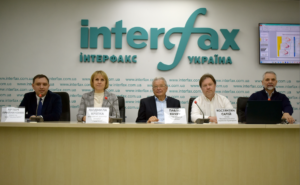
The King Salman Center for Rescue and Humanitarian Assistance (KSRelief) has donated $10 million to the United Nations World Food Program (WFP). King Salman Rescue and Humanitarian Relief Center (KSRelief) has donated $10 million to the United Nations World Food Program (WFP) to support war-affected Ukrainians in 1,200 facilities across the country with daily hot meals, according to the WFP press office.
“We are grateful to KSRelief for supporting a vital component of our emergency assistance programs in Ukraine that supports the most vulnerable Ukrainians and strengthens the local institutions and organizations that care for them,” said Marianne Ward, acting director of WFP Ukraine.
According to a press release, the agreement was signed between H.E. Dr. Abdullah Al Rabia, Advisor to the Royal Court and General Manager of KSRelief, and WFP Executive Director Cindy McCain.
Saudi Arabia’s contribution will help provide 50 million meals to the institutions that WFP supports (hospitals, shelters for internally displaced persons, orphanages, neuropsychiatric and geriatric institutions, and other public or private organizations that care for vulnerable Ukrainian citizens).
“We are pleased to be part of this important emergency program to respond to the urgent humanitarian needs of the affected population in Ukraine. KSrelief’s humanitarian assistance will provide vital food aid to the most vulnerable communities across the country,” the press office quoted KSRelief’s Assistant General Manager for Planning and Development, Ahmed Al Baiz, as saying.
The assistance provided will allow the purchase and delivery of about 7,600 tons of food. It is noted that all products, including flour, pasta, buckwheat, oatmeal, peas, sugar and oil, are purchased from Ukraine to support the local economy and food system.
Over the next six months, WFP’s institutional feeding program plans to provide food assistance to 210,000 vulnerable Ukrainians. KSRelief’s contribution will cover a significant portion of the program’s needs – approximately 67%. This is support for 140 thousand people.
During 2023, WFP’s institutional feeding program supported 460,000 Ukrainians in Cherkasy, Chernihiv, Chernivtsi, Dnipropetrovsk, Donetsk, Ivano-Frankivsk, Kharkiv, Kherson, Khmelnytskyi, Kirovograd, Kyiv, Lviv, Mykolayiv, Odessa, Poltava, Rivne, Sumy, Ternopil, Vinnytsia, Volyn, Zakarpattya, Zaporizhzhya and Zhytomyr regions.
Institutional feeding is one of the many ways WFP supports Ukrainians affected by the war. WFP is also distributing food packages in areas close to the front line where food is hard to find or very expensive, distributing cash assistance to vulnerable Ukrainians across the country, and supporting the safe release of agricultural land mines in Kharkiv Oblast to help farmers and food producers. WFP has also chartered 25 ships to export Ukrainian grain to countries in need through the Black Sea Grain Initiative and Grain from Ukraine.
The United Nations World Food Programme is the world’s largest humanitarian organization that saves lives in emergencies and uses food aid to build a path to peace, stability and prosperity for people recovering from conflict, natural disasters and the effects of climate change.

A feed mill in the Poltava Oblast plans to expand its capacity to process corn and pea grain, the USAID Agro Program reported on Facebook.
According to the report, the Lokhvitsky Feed Mill will implement the grant project in cooperation with the agency.
Under the project, the enterprise will begin construction of a cereal plant that produces corn groats and flour, and will also process peas. The operation is scheduled to start up in November this year.
The plant is expected to produce up to 120 tons of grain per day. It will operate on new equipment from a Ukrainian manufacturer. The plant plans to cooperate with farmers who will grow corn on the seed provided to them.

Ukraine needs to approve standards for recycling construction waste resulting from military operations and develop recipes for processing various materials, said Konstantin Saliy, president of the All-Ukrainian Union of Construction Materials Producers (VSPB).
“The lack of state standards for the recycling and processing of construction materials – demolition waste – is the biggest obstacle to development. According to EU standards, this construction waste should not create landfills on the outskirts of our cities, but should be recycled. But the problem is that the government has not even raised this issue publicly in two years. We, the unions and associations, are raising it, and we hope that there will be a donor structure that will help Ukraine with a grant, and we will be able to conduct a scientific study on the development of recipes for processing various types of waste,” Saliy said at the round table “Building Materials. Preparedness for Market Needs for Recovery” at the Interfax-Ukraine agency on Tuesday.
He reminded that, according to preliminary estimates, Ukraine has 100 million cubic meters of waste due to military destruction, but this figure does not cover waste in the temporarily occupied territories affected by the Russian invasion.
According to the expert, the cost of the initial study of formulations for recycling construction waste is estimated at $200 thousand, and the construction of a laboratory – $3-5 million.
“The issue of building materials recycling is very interesting because Europe did not experience such destruction after 1945, and the materials were completely different. In addition, not all materials can be recycled – objects hit by some missiles become toxic. A lot of research needs to be done, and it is difficult to do it with just one laboratory. It is necessary to have a full laboratory for toxicology, sanitary tests, and fire loads,” explained the president of the VSPU.

The Ministry of Agrarian Policy and Food forecasts in 2024 gross production of grain and oilseeds at the level of 74 million tons, of which about 52.4 million tons of cereals and 21.7 million tons of oilseeds.
As noted on the agency’s website, at the beginning of last year, the total gross harvest of grains and oilseeds for 2023 was also forecast to be almost 13% lower than the previous period, at 63.5 million tons, but weather conditions led to an increase in the harvest. Therefore, gross production in 2023 is about 82 million tons, of which cereals more than 60 million tons and oilseeds about 22 million tons.
“Forecasts for gross harvest figures are preliminary and will be adjusted during the year depending on circumstances, primarily weather conditions,” the Ministry of Agrarian Policy emphasized.
According to the forecast, in 2024, farmers will be able to harvest cereals in the following volumes: wheat – 19.2 million tons (22.2 million tons were harvested last year), barley – 4.9 million tons (5.7 million tons in 2023) and corn – 26.7 million tons (30.5 million tons).
Among oilseeds, soybeans are projected to increase. This crop is expected to produce 5.2 million tons, a year earlier 4.7 million tons were harvested. Sunflower production is forecast at 12.4 million tons versus 12.9 million tons, respectively. Rapeseed is planned to be harvested at 4.1 million tons, while last year’s crop was 4.7 million tons.
Sown areas of grain and leguminous crops are forecast at 10.6 million hectares, which is 395 thousand hectares less than in 2023. Of these, winter wheat is sown on 4.3 mln ha (-0.3 mln ha), spring wheat – 0.2 mln ha. (+0.2 thousand ha), winter barley – 0.47 million ha (-0.15 million ha).
The area of spring barley is forecasted at 0.94 million hectares (+0.06 million hectares), corn – 3.9 million hectares (-62 thousand hectares).
Among oilseeds, the area sown with soybeans is increasing. It is forecasted that it will be sown on the area of 2.2 million hectares. This is almost 400 thousand hectares more than last year. Sunflower will be sown almost as much as last year – 5.3 million hectares, rape – 1.5 million hectares, which is 0.1 million hectares less than last year.
The Ministry of Agrarian Policy, based on the results of a survey conducted in the State Agrarian Register on the preparation of agricultural producers for the sowing campaign of spring crops for the harvest-2024, reported that 70% of respondents plan to increase the area under soybean by an average of 21% compared to 2023.
The survey also showed that during the spring sowing season Ukrainian agrarians will prioritize grain legumes, the sown areas under which will increase by 11%, and spring barley – by 7%. It is expected that sown areas under spring rape will increase by 24%, sugar beet – by 17%, and under corn will decrease by 9%. Sunflower areas may potentially decrease.
Earlier, the Ministry of Agrarian Policy allowed a reduction in 2024 sown areas under spring crops by 0.5 million hectares or 3.7% compared to last season.

Representatives of the Embassy of the Republic of Poland, prosthesis manufacturer EnForce Medical Technologies, and the Siepomaga Charitable Foundation, together with representatives of the Ministry of Veterans Affairs, visited the center for social and psychological rehabilitation in Borodyanka, Kyiv region, where they are considering the possibility of establishing a Ukrainian-Polish prosthetics center.
“It is planned that people will be able to receive prosthetics and undergo rehabilitation in such an institution,” the Ministry of Reintegration of the Temporarily Occupied Territories of Ukraine reports.
Veterans, participants of the Invictus Games, were the first to inspect the facility. In particular, they tested the accessibility, availability of everything necessary for the psychological and physical rehabilitation of veterans with disabilities, and checked the quality of services.
Now an expert assessment is expected from the Polish side on the possibility of its placement in the Borodyansky Center.
The initiative to establish the Ukrainian-Polish Prosthetics Center was discussed within the framework of the Ukrainian-Polish intergovernmental commission.
The possibility of expanding the existing center through additional construction is under discussion.

In January-March this year, ArcelorMittal Kryvyi Rih Iron and Steel Works (AMKR, Dnipro region) increased steel production by 93% year-on-year to 278 thousand tons.
According to the company, compared to the fourth quarter of last year, iron ore concentrate production amounted to 1.775 million tons versus 1.283 million tons (38% more).
Blast furnace coke production in January-March 2023 amounted to 245 thousand tons compared to 211 thousand tons (up 16%), pig iron – 403 thousand tons compared to 392 thousand tons (up 3%), steel – 278 thousand tons compared to 250 thousand tons (up 11%), rolled products – 262 thousand tons compared to 230 thousand tons (up 14%). Production growth compared to the first quarter of 2023 ranged from 50% to 94%, depending on the type of product.
In March 2024, compared to March 2023, production of iron ore concentrate increased by 52% (from 427 thousand tons to 651 thousand tons), blast furnace coke by 50% (from 56 thousand tons to 84 thousand tons), pig iron by 27% (from 109 thousand tons to 138 thousand tons), steel by 61% (from 77 thousand tons to 124 thousand tons) and rolled products by 57% (from 74 thousand tons to 116 thousand tons). Production volumes also grew year-on-year, with iron ore concentrate up 14%, blast furnace coke up 9%, pig iron up 19%, and steel and rolled products up 61% and 59%, respectively.
These results were achieved despite Russian attacks against energy infrastructure and the resulting power outages, the press release said.
The first quarter of 2024 also reflects gradual progress in restoring the company’s production capacity.
“We plan to continue our production development program, in particular, to approach 50% utilization of our steelmaking capacity in the near future. At the same time, the stability of energy supply remains a significant factor in the successful implementation of our plans,” said Mauro Longobardo, CEO of AMKR.
“ArcelorMittal Kryvyi Rih is the largest rolled steel producer in Ukraine. It specializes in long products, including rebar and wire rod.
ArcelorMittal owns the largest mining and metallurgical plant in Ukraine, ArcelorMittal Kryvyi Rih, and a number of small companies, including ArcelorMittal Berislav.
Mittal Steel Corporation acquired a 93.02% stake in Kryvorizhstal in an open tender on October 24, 2005 for UAH 24.2 billion at a starting price of UAH 10 billion, after which the plant was renamed Mittal Steel Kryvyi Rih and later ArcelorMittal Kryvyi Rih.